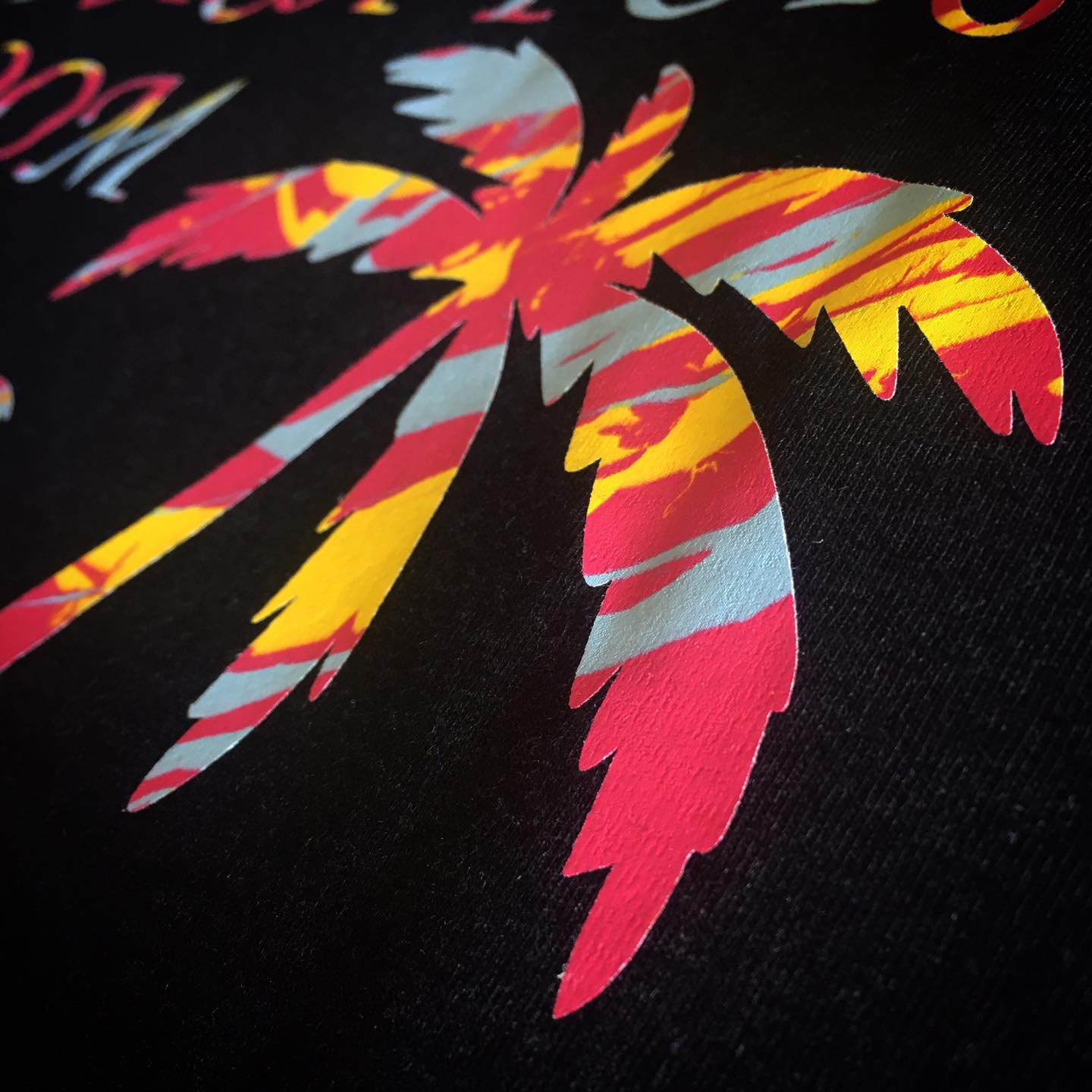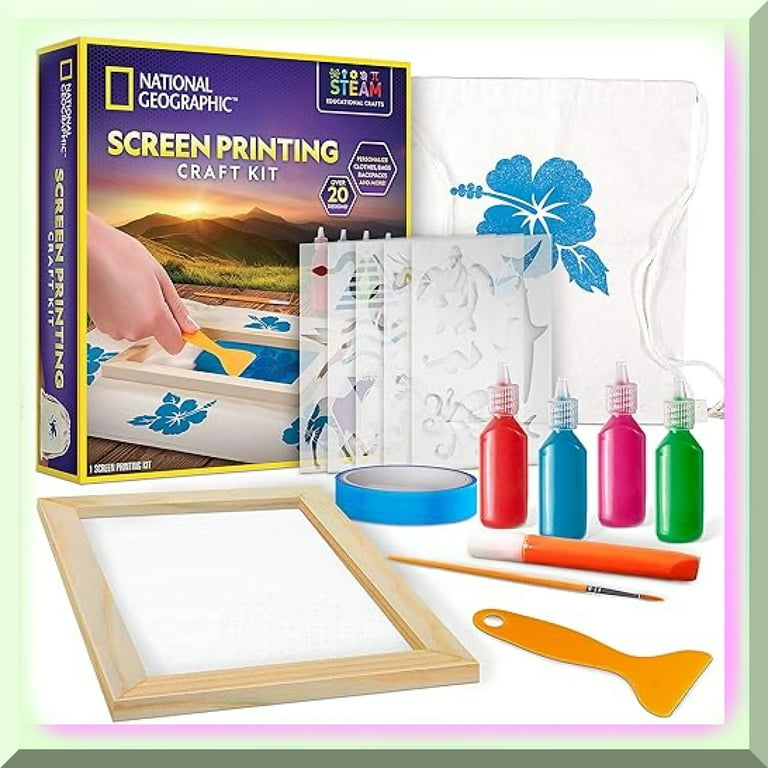Eco-Friendly Custom Screen Printing Options Available
Wiki Article
Screen Printing Uncovered: Everything You Need to Understand About Tee and Garment Printing Methods
If you've ever wondered just how those lively designs finish up on your preferred tees, you're in the appropriate location. Display printing is a fascinating approach that integrates art with strategy, using limitless possibilities for creative thinking. Understanding the principles, from equipment to ink selections, can considerably influence your outcomes. Prepared to check out the necessary components that make display printing an art type? Allow's reveal the details that can elevate your tasks.
The Essentials of Display Printing: Just How It Functions
When you plunge right into screen printing, you'll find it's both an art and a scientific research. At its core, screen printing involves creating a pattern, or display, that enables ink to pass with only in details locations (screen printing kit). You begin by choosing your layout and preparing your display with a light-sensitive emulsion. As soon as you subject this emulsion to light, it sets, leaving your layout as an unfavorable area.Position the screen over the fabric, after that make use of a squeegee to push ink with the screen onto the garment. Each action is crucial, and grasping them will certainly boost your screen printing skills, changing straightforward garments into one-of-a-kind, meaningful pieces.
Sorts Of Screen Printing Strategies
Once you realize the fundamentals of screen printing, it's time to explore the various strategies that can elevate your layouts. One preferred method is typical display printing, where ink is pressed via a stenciled display.An additional alternative is plastisol printing, understood for its durability and brilliant shades, making it a favorite for numerous brand names. Experiment with halftone printing to develop slope results and intricate designs.
Essential Tools for Screen Printing
To achieve sensational cause screen printing, having the right devices is essential. First, you'll need a durable display printing frame, which holds the mesh that moves your style onto the garment. Next off, purchase premium squeegees; these are crucial for applying ink equally across the display. You'll additionally need an excellent exposure unit to develop your screens, in addition to a washout booth for cleansing them after use. A trusted warm resource, like a conveyor clothes dryer or heat press, is vital for healing your prints to assure durability. Do not forget a correct work area, equipped with tables and storage space for your materials. Safety equipment, such as masks and gloves, will certainly keep you risk-free from chemicals and inks. With the right tools, you'll be well on your method to generating professional-quality prints.Selecting the Right Inks and Products
When picking inks and materials for screen printing, you require to take into account the kind of ink that works best for your task. Believe regarding fabric compatibility to assure your styles look excellent and last long. Likewise, discover environmentally friendly ink alternatives to make your printing process much more sustainable.Kinds Of Screen Inks
Choosing the appropriate display ink is vital for accomplishing dynamic, durable prints that fulfill your job's requirements. There are several sorts of display inks to check out. Plastisol ink is popular for its flexibility and simplicity of use, providing exceptional shade opacity on dark textiles. Water-based ink, on the various other hand, uses a softer feel and is environmentally friendly, making it perfect for those looking to decrease their environmental influence. Discharge inks eliminate color from the material, resulting in a soft, vintage appearance however require details handling. Ultimately, specialty inks, such as metal or glow-in-the-dark, can add distinct effects to your layouts. Evaluate your task needs and select the ink that lines up best with your wanted end result.
Fabric Compatibility Considerations
Understanding textile compatibility is important for attaining high-grade screen prints, particularly considering that various products respond uniquely to various inks. When choosing inks, consider the textile kind-- cotton, polyester, or blends. For cotton, water-based inks work well, offering soft qualities and breathability. Polyester, on the various other hand, commonly needs plastisol inks for much better adhesion and vibrant shades. You might require to make use of a mix of both types if you're printing on blends. Always test your inks on example material to guarantee they stick effectively and keep color integrity. Additionally, bear in mind that fabric weight and texture can affect the last end result, so choosing the right ink and product combo is crucial for your project's success.Eco-Friendly Ink Options
Environment-friendly inks are coming to be a popular option for display printers who intend to decrease their environmental effect while keeping quality. When picking inks, consider water-based inks, which are much less hazardous and less complicated to tidy up contrasted to conventional solvents. These inks bond well with fabrics, supplying vivid outcomes without hazardous chemicals. You may also check out eco-solvent inks that utilize less volatile natural compounds (VOCs), making them a much safer alternative for both your wellness and the earth.Furthermore, try to find inks made from renewable energies, such as soy or vegetable-based alternatives. By picking the appropriate inks and products, you'll not just produce stunning layouts yet additionally contribute to a much more sustainable printing procedure. Make the switch, and your prints will reflect your dedication to the setting!
Preparing Your Style for Screen Printing

File Layout Demands
To ensure your style looks vivid and sharp on fabric, you'll need to pay very close attention to file format requirements for display printing. Beginning with vector files like AI or EPS, as they can be scaled without shedding quality. If you make use of raster pictures, choose high-resolution data, such as TIFF or PNG, preferably at 300 DPI. Avoid making use of JPEGs, as they can shed clarity when resized. Make sure your style has a transparent background to prevent unwanted white sides on your prints. Ultimately, maintain color settings in mind; CMYK is basic for display printing, so transform your RGB creates as necessary. By complying with these standards, you'll set your artwork up for an effective print.Color Splitting Up Techniques
Shade separation is an important action in preparing your design for display printing, and mastering it can considerably boost your print high quality. You'll need to break your layout into private shades, as each shade needs a separate display during printing. Beginning by identifying all the shades in your layout and develop layers each. You can use software like Adobe Photoshop or Illustrator to separate and different colors successfully. Be particular to conserve each layer as custom screen printing a different documents, generally in a format like TIFF or PSD. This precision not just guarantees precise shade representation however additionally enhances the printing procedure. By focusing on color splitting up, you'll accomplish professional and vibrant cause your screen-printed garments.Resolution and Size
Attaining the best cause display printing starts with guaranteeing your design has the ideal resolution and size. Preferably, your artwork needs to be at least 300 DPI (dots per inch) for sharp, clear prints. Your last item might look pixelated and amateur. if you make use of reduced resolution.When it comes to dimension, think about the dimensions of your print location. Layout your art work to match the final print size, ideally developing it in the real dimensions you'll be printing. This method, you'll stay clear of any unforeseen scaling concerns.
Always check your style in both vector and raster layouts. Vector graphics can be scaled without losing high quality, making them ideal for screen printing. Preparing properly will assure your design looks incredible on every garment!
Step-by-Step Display Printing Refine
Screen printing is a vibrant procedure that allows you to create vivid layouts on various surfaces. To get going, you'll require a display, solution, and your picked ink. Initially, prepare your display by cleansing it extensively. Next, apply the solution equally and allow it completely dry in a dark location. As soon as completely dry, reveal your display to light with your layout positioned on it, which will certainly set the emulsion where the light hits, developing a pattern - screen printing kit.After rinsing the unexposed emulsion, your display is ready. Establish it up on your printing surface and align your garment underneath it. Put ink onto the screen and use a squeegee to push the ink with the pattern onto the fabric. Raise the screen very carefully and let the print dry. Heal the ink utilizing heat to assure longevity. That's it! You've effectively screen published your design.
Tips for Successful Display Printing Projects
While you're diving right into your screen printing projects, remember that preparation is crucial to success. Start by collecting all your materials-- inks, mops, garments, and screens. A clean workspace assists prevent undesirable mistakes, so clean prior to you start.Next, confirm your artwork is high-resolution and properly sized for your garment. Check your display for appropriate exposure and tidy it completely to stay clear of spots. When blending your inks, adhere to the supplier's standards to attain the ideal uniformity.
Throughout printing, apply even pressure with your squeegee for constant outcomes. Don't rush; take your time to confirm each print fulfills your requirements. After printing, let your garments dry entirely before taking care of or packaging them.
Last but not least, always maintain an example of your benefit future reference. In this manner, you can evaluate your development and boost your methods in time. Happy printing!

Often Asked Inquiries
Just how Lengthy Does It Require To Establish up a Display Printing Job?
Establishing a screen printing work commonly takes about thirty minutes to an hour. You'll prepare the screens, mix inks, and adjust journalism. The moment varies based on complexity and experience, so remain arranged!Can I Publish on Various Fabric Types Using the Exact Same Strategy?
Yes, you can print on different textile types utilizing the very same method, but you'll need to readjust your inks and setups. Some fabrics soak up ink in a different way, so trying out guarantees the best outcomes for each product.What Are Common Mistakes to Avoid in Screen Printing?
When screen printing, prevent usual mistakes like making use of the wrong ink, ignoring proper exposure times, or missing pre-press checks. Constantly test your setup and preserve clean displays to ensure quality outcomes each time.How Can I Correctly Tidy and Keep My Display Printing Devices?
To appropriately clean and maintain your display printing devices, you should routinely clean screens with proper solvents, inspect squeegees for wear, and ensure all devices are stored dust-free and completely dry. Consistency protects against costly fixings and improves efficiency.Is Screen Printing Eco-friendly Compared to Other Approaches?
Display printing can be a lot more eco-friendly than various other techniques, specifically if you make use of eco-conscious materials and water-based inks. By selecting lasting supplies and practices, you minimize waste and minimize your impact on the world.Display Printing Uncovered: Everything You Need to Know Concerning T-Shirt and Garment Printing Methods
At its core, screen printing includes developing a pattern, or screen, that allows ink to pass via just in certain locations. Placement the display over the textile, then utilize a squeegee to push ink through the display onto the garment. One popular approach is typical display printing, where ink is pushed via a stenciled display.When selecting inks and products for screen printing, you need to take into account the type of ink that works best for your project.
Report this wiki page